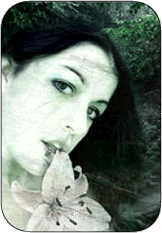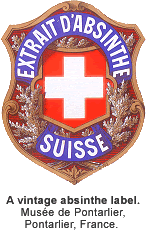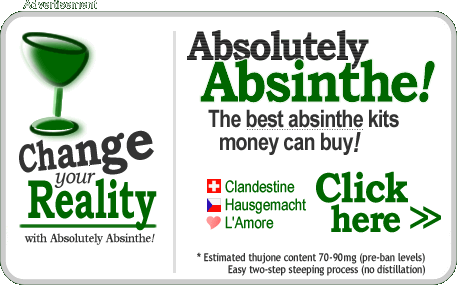Absinthe is back! Are you ready
to fly with the Green Fairy?
By MsJekyll • Posted April 1997
To be updated soon.
 Absinthe was invented in 1797 by Dr. Pierre Ordinaire. Henri-Louis Pernod opened the first absinthe distillery in Switzerland and then moved to a larger one in Pontarlier, France in 1805. By the 1850's it had become the favorite drink of the upper class. Originally wine based, a blight in 1870's on the vineyards forced manufacturers to base it with grain alcohol. Everyone could now afford it. The bohemian lifestyle embraced it.
Absinthe was invented in 1797 by Dr. Pierre Ordinaire. Henri-Louis Pernod opened the first absinthe distillery in Switzerland and then moved to a larger one in Pontarlier, France in 1805. By the 1850's it had become the favorite drink of the upper class. Originally wine based, a blight in 1870's on the vineyards forced manufacturers to base it with grain alcohol. Everyone could now afford it. The bohemian lifestyle embraced it.
The Green Fairy (la fee verte) as it became commonly known, was most popular in France. Most days started with a drink and ended with the "green hour" (l'heure verte) as one or two or more were taken for its aperitif properties. It is interesting to note that it also has aphrodisiac and narcotic properties. Authors and artists were proponents for using it to induce creativity.
Absinthe's popularity soared from 1880 on. Advertisements touted it as being healthful. It was exported to New Orleans and reached the same acclaim in the United States. It was one of the few drinks considered lady-like and women freely enjoyed it in the coffee houses where it was most commonly served. Victorian era men however, found women freely enjoying absinthe distasteful.
In 1905, Jean Lanfray who was very intoxicated, murdered his wife. He supposedly only had two glasses of absinthe but none the less, his trial became known as the "Absinthe Murder". Prohibition movements were underway. Absinthe was singled out as the maddening culprit and became synonymous with alcohol. Experiments started to be conducted often by injecting large doses of the oil of wormwood into animals. Absinthism was named as a disease. On July 25th, 1912, the Department of Agriculture issued Food Inspection 147, which banned absinthe in America, and finally France followed in 1915.
But is it (real) absinthe?
Updated March 2009
A lot has changed since absinthe was banned in the beginning of the 20th century. In Europe, the Green Fairy flies freely again following recent re-legalization, and there are some excellent absinthes to be had.
Unfortunately, absinthe-thirsty Americans are not so lucky yet. Although the US authorities have now permitted the use of the term "absinthe" on bottle labels (subject to approval and conditions), all "absinthes" sold in the US must test thujone-free. But once you remove thujone—the natural essential oil of the Artemisia plant—it's no longer absinthe; it's just a green drink that will get you drunk fast, but no effect beyond that.
As someone who has drunk absinthe since 1997, I am very disappointed – because as long as these absinthe-like imitations continue to plague U.S. liquor stores, posing as the genuine article, there will be no pressure on the US authorities to relent and allow real European absinthes into America's stores and bars. Essentially, the FDA/TTB policies have done absolutely nothing for America's absintheurs; they have just opened doors to producers with a buck on their mind and green-colored vodkas to sell.
I want to take this opportunity to recommend the Buy Absinthe guide, which aims to be a no-nonsense resource for newcomers and seasoned absinthe drinkers alike. Though still quite new, the guide is already packed with useful tips that any absinthe buyer will appreciate. I've known the writer for years and I can confirm his opinions are well worth listening to.
But what is absinthe?

Absinthe is an alcoholic drink made with an extract from wormwood (Artemisia absinthium). It is an emerald green drink which is very bitter (due to the presence of absinthin) and is therefore traditionally poured over a perforated spoonful of sugar into a glass of water. The drink then turns into an opaque white as the essential oils precipitate out of the alcoholic solution (louche).
Absinthe was once popular among artists and writers and was drunk by Van Gogh, Baudelaire, and Verlaine, to name a few. It appears to have been believed to stimulate creativity. However, in the 1850's, there began to be concern about the results of chronic use. Chronic use of absinthe was believed to produce a syndrome, called absinthism, which was characterized by addiction, hyperexcitability, and hallucinations.
This concern over the health effects of absinthe was amplified by the prevailing belief in Lamarckian theories of heredity. In other words, it was believed that any traits acquired by absinthists would be passed on to their children. Absinthe's association with the bohemian lifestyle also worked to compound fears about its effects, much as has happened with marijuana in America. Absinthe was subsequently banned in many countries in the beginning of the 1900's.
Ingredients of the emerald drink
Simon and Schulter's "Guide to Herbs and Spices" tells us that Henri-Louis Pernod used aniseed, fennel, hyssop, and lemonbalm along with lesser amounts of angelica, star anise, dittany, juniper, nutmeg, and veronica. These ingredients were macerated together with wormwood plants. After leaving the mixture to sit, water was added and the mixture was distilled. Dried herbs, including more wormwood, were added to the distillate, which was then diluted with alcohol to give a concentration of about 75% alcohol by volume. Different absinthe manufacturers used slightly different ingredients, sometimes using calamus, which has been purported to have psychoactive effects.
In addition to these ingredients, manufacturers sometimes added other ingredients to produce the drink's emerald green color. Normally, this color was due to the presence of chlorophyll from the plants. However, in the event that the product was not properly colored, absinthe makers were known to add things like copper sulfate, indigo, turmeric, and aniline green. Antimony chloride was also used to help the drink become cloudy when added to water. Presumably modern makers of Pernod and absinthe use safer ingredients for their concoctions!
See Dick's Recipe for Absinthe and more detailed ingredient information.
Modern alcoholic beverages related to absinthe
Herb Sainte and Pernod are names of modern wormwood-free absinthes. Typically, additional star anise is added to balance the flavor. Herb Sainte is manufactured in New Orleans. Pernod is named after Henri-Louis Pernod, who founded the most important absinthe distillery in France in the early 1800s.
Pastis is a similar liqueur to absinthe and was also originally made with wormwood. However, the dominant flavor in pastis is licorice (rather than the star anise of modern Pernod or HerbSainte). Pastis brands include Ricard, Duval, Jeannot, Casanis, and Henri Bardouin. Vermouth, chartreuse, and benedictine absinthe contain small amounts of thujone. In fact, vermouth, which is made using the flower heads from wormwood, takes its name from the German wermuth ("wormwood"). There are, of course, many other essential oil containing drinks, such as Ouzo and Jagermeister. Wormwood is popular as a flavoring for brannvin (an alcoholic drink made from potatoes) in Sweden.
Famous absinthe drinkers include:
|
|
Want to talk with the Fairy
about absinthe or else?
Write to greenfairy (at) msjekyll (dot) com anytime...


More @ MsJekYll.com » Axis | Absinthe & the Green Fairy | Poetry | The Mayfair Witches | Site Map
Other good sitez:

Check out Cassandra's Swiss & Bohemian
homemade absinthe
![]()
Absinthe Kits

The Absinthe Buyer's Guide provides a listing of absinthe
currently being produced for sale worldwide.
Includes photos, history, books, absinthe vendors
and links to absinthe related sites.
Also check out Century - an absinthe
with 100mg thujone





